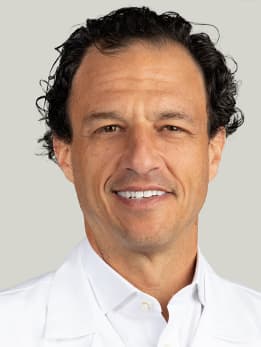They did surgery on a grape, and we did a Q&A with a surgeon about it

A 2010 video by Edward Hospital (featured below) recently resurfaced in the form of the more than 10,000 patients in various service lines at UChicago Medicine. During these procedures, a surgeon sits in the operating room at a machine, which has a viewfinder and tools to operate with their fingers. Meanwhile, surgical assistants and techs surround the patient, hooking up the robot’s arms to surgical tools and assisting with the operation.
We spoke with Scott Eggener, MD, professor of surgery and radiology and director of UChicago Medicine’s Prostate Cancer Program, about how the robot is used at our South Side Chicago hospital.
UChicago Medicine: What is the da Vinci robot used for, and how often do you use it?
Eggener: Within urology, the primary uses are prostate and kidney surgeries. Our group has done more than 5,000 robotic urologic surgeries. We use the robot every day.
Why would someone opt for robotic surgery over traditional methods?
Robotic surgery is less invasive, there’s less blood loss and it requires less pain medication, which is especially important right now because of the opioid epidemic. In kidney and prostate surgery, you can be a lot more precise compared to pure non-robotic laparoscopic surgery.
How are robots more precise?
Compared to laparoscopic surgery, the hand motions are more elaborate. We call this “more degrees of freedom” in your hand. Essentially, you have more flexibility and capability. This was a big deal about a decade ago, but now robotic surgery is commonplace. There’s nothing super innovative about it in 2018.
In the original video, they do surgery on a grape by peeling back and then re-stitching the skin. What does this really tell us about the capability of the robot?
There’s an ability to magnify the picture of what you’re doing surgery on, and this allows for a lot of precision. If you have a tremor in your hand, it takes the tremor out. There’s a lot more control of the instrument.
If you could do surgery on a fruit, what would it be and why?
Mango, it's the tastiest fruit and I could eat it after.
What’s an interesting fact about this robot?
I think one of the cool things is that it was developed by our government defense organizations in the Pentagon for doing remote surgeries during wartime. That way, if someone got injured on a battlefield, they could hypothetically hook a robot up to the patient and operate from overseas. That didn’t end up happening—the robot got sold into the private industry, and now it’s commonplace in hospitals like ours.

Scott Eggener, MD
Scott Eggener, MD, is an experienced robotic and open surgeon who specializes in the care of patients with prostate, kidney and testicular cancers.
Learn more about Dr. Eggener
